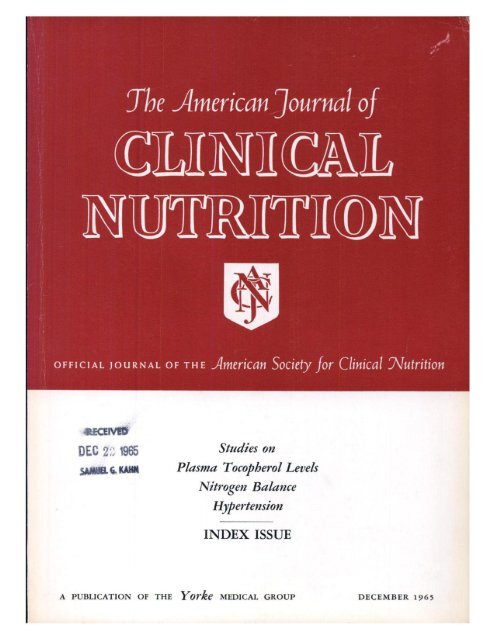短链脂肪酸动力学和浓度在年轻人和老年人补充菊粉后更高:一项随机试验。
IF 6.5
1区 医学
Q1 NUTRITION & DIETETICS
引用次数: 0
摘要
背景:有益的短链脂肪酸(SCFAs)是通过肠道微生物纤维发酵产生的。使用稳定示踪剂方法和区室模型,我们观察到老年人(OAs)的SCFA产量低于年轻人(YAs)。和不可接近的[可能代表肠道吸收微生物产生的SCFAs (U2)]池。目的:我们现在研究纤维补充是否会增加oa中短链脂肪酸的产生,以及浓度是否反映了生产速率的变化。方法:在这项随机、安慰剂对照、双盲交叉研究中,21岁(20-29岁)和40岁(59-87岁)的成年人分别补充菊粉或安慰剂(麦芽糊精)7天(最终摄入量:30克/天)。在干预之前和之后,参与者收集粪便,并接受含有[U-13C]标记的scfa的静脉脉冲,然后抽血。我们通过气相色谱-质谱法测量了血浆示踪剂浓度、血浆和粪便浓度,并进行了区室分析。数据均为平均值(95%置信区间)。结果:菊粉诱导不可接近池{YA: 28-44[+16.2(4.3, 28.1)]中丁酸酯产量(μmol/min)增加44%;P = 0.038], oa: 14-20 [+6.1 (2.2, 9.9);P = 0.011]},且两组间差异无统计学意义。此外,仅YA的丙酸产量就增加了34%。我们发现OA患者的粪便醋酸盐、丙酸盐和丁酸盐增加了50%-60%,血浆丁酸盐增加了34%,而YA患者的粪便醋酸盐仅增加了34%。血浆而非粪便浓度与不可接近池中SCFA产量呈正相关(R2 = 0.20-0.45;P < 0.001)。结论:oa具有较低的SCFA产量。菊粉的摄入增加了短链脂肪酸的产量。示踪脉冲方法检测SCFA代谢变化比血浆或粪便浓度测量更敏感(NCT04459156)。本文章由计算机程序翻译,如有差异,请以英文原文为准。
Short-chain fatty acid kinetics and concentrations are higher after inulin supplementation in young and older adults: a randomized trial
Background
Beneficial short-chain fatty acids (SCFAs) are produced through intestinal microbial fiber fermentation. Using stable tracer methodology and compartmental modeling, we observed lower SCFA production in older (OAs) than in young adults (YAs) in both an accessible [that is, systemic circulation; whole-body production] and inaccessible [potentially representing intestine absorbing microbially produced SCFAs (U2)] pool.
Objectives
We now investigated whether fiber supplementation increases SCFA production in OAs and whether concentrations reflect production rate changes.
Methods
In this randomized, placebo-controlled, double-blind crossover study, 21 YAs (20–29 y) and 40 OAs (59–87 y) adults were supplemented with inulin or placebo (maltodextrin) for 7 d (final intake: 30 g/d). Before and after interventions, participants collected stool and received an intravenous pulse containing [U-13C]-labeled SCFAs followed by blood draws. We measured plasma tracer enrichments, plasma and fecal concentrations by gas chromatography–mass spectrometry and performed compartmental analysis. Data are mean (95% confidence interval).
Results
Inulin evoked a 44% increase in butyrate production (μmol/min) in the inaccessible pool {YA: 28–44 [+16.2 (4.3, 28.1); P = 0.038], OA: 14–20 [+6.1 (2.2, 9.9); P = 0.011]} and were not different between YAs and OAs. In addition, a 34% increase in propionate production in YA only. We found a 50%–60% increase in fecal acetate, propionate, and butyrate and a 34% increase in plasma butyrate in OA, whereas in YA only 34% increase in fecal acetate. Plasma but not fecal concentrations correlated positively with SCFA production in the inaccessible pool (R2 = 0.20–0.45; P < 0.001).
Conclusions
OAs have a lower SCFA production. Inulin intake increases SCFA production. Tracer pulse approach detects SCFA metabolism changes more sensitively than plasma or fecal concentration measurements (NCT04459156).
求助全文
通过发布文献求助,成功后即可免费获取论文全文。
去求助
来源期刊
CiteScore
12.40
自引率
4.20%
发文量
332
审稿时长
38 days
期刊介绍:
American Journal of Clinical Nutrition is recognized as the most highly rated peer-reviewed, primary research journal in nutrition and dietetics.It focuses on publishing the latest research on various topics in nutrition, including but not limited to obesity, vitamins and minerals, nutrition and disease, and energy metabolism.
Purpose:
The purpose of AJCN is to:
Publish original research studies relevant to human and clinical nutrition.
Consider well-controlled clinical studies describing scientific mechanisms, efficacy, and safety of dietary interventions in the context of disease prevention or health benefits.
Encourage public health and epidemiologic studies relevant to human nutrition.
Promote innovative investigations of nutritional questions employing epigenetic, genomic, proteomic, and metabolomic approaches.
Include solicited editorials, book reviews, solicited or unsolicited review articles, invited controversy position papers, and letters to the Editor related to prior AJCN articles.
Peer Review Process:
All submitted material with scientific content undergoes peer review by the Editors or their designees before acceptance for publication.

 求助内容:
求助内容: 应助结果提醒方式:
应助结果提醒方式:


